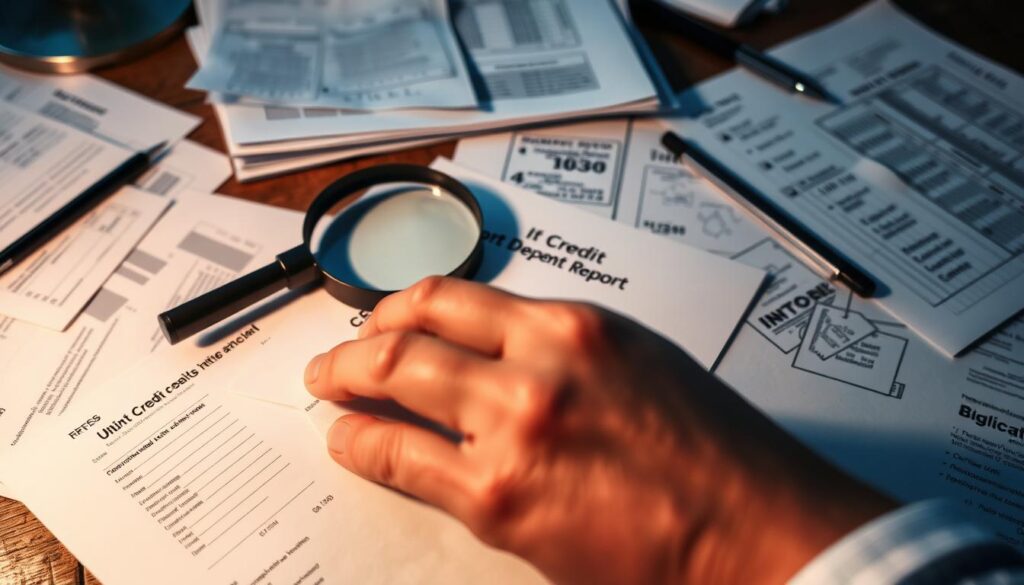A healthy credit score is vital in today’s financial world. Errors on credit reports can harm your creditworthiness. This guide shows how to dispute errors with Experian, Equifax, and TransUnion.
The credit bureau dispute process is key to protecting your finances. You can challenge unfair reporting and boost your credit score. This article covers crafting dispute letters and using debt validation.
Key Takeaways
- Understand the importance of accurate credit information and common reasons for credit report errors
- Learn the step-by-step credit bureau dispute process and how to initiate a successful dispute
- Discover the role of debt validation letters in challenging creditors and unverified debts
- Explore examples of effective dispute letters for addressing inaccurate personal information and derogatory credit entries
- Uncover the key elements of a compelling dispute letter and best practices for credit repair correspondence
- Familiarize yourself with timelines and escalation procedures for following up on credit report disputes
- Recognize the significance of providing supporting documentation to substantiate your claims
Understanding Credit Report Disputes
Accurate credit information is vital for your financial health. Credit report disputes help maintain your credit history’s integrity. Common reasons for errors include identity theft, mistaken identity, and creditor mistakes.
The Importance of Accurate Credit Information
Your credit report shows your financial activities. It includes payment history, credit use, and public records. Lenders, landlords, and employers use this information to assess your creditworthiness.
Errors in your credit report can cause problems. You might face loan denials, higher interest rates, or missed job opportunities.
Common Reasons for Credit Report Errors
Credit report errors can come from various sources. Here are some common causes:
- Identity Theft: Fraudulent accounts or unauthorized activity on your credit report can result from identity theft.
- Mistaken Identity: Similar names or Social Security numbers can lead to information from another person’s credit history being included in your report.
- Creditor Errors: Clerical mistakes or miscommunications between creditors and credit bureaus can result in inaccurate information appearing on your credit report.
Recognizing these issues is crucial. It’s the first step in starting effective credit report disputes. This helps restore your credit information’s accuracy.
“Inaccuracies in your credit report can have a significant impact on your financial future. It’s crucial to address these issues proactively.”
Credit Bureau Dispute Process Overview
Challenging errors on your credit report is crucial. The three major credit bureaus have guidelines for disputing inaccurate information. Experian, Equifax, and TransUnion all follow these processes.
To start a credit report dispute, contact the bureau reporting the error. You can submit disputes online, by mail, or phone. The bureau must investigate within 30 days and provide results.
Gather documents supporting your claim, like payment records or account statements. Clearly identify the disputed items and explain why they’re inaccurate. Submit your dispute promptly to ensure investigation.
- Gather all relevant documentation that supports your dispute, such as payment records, account statements, or other evidence.
- Clearly identify the specific items on your credit report that you are disputing and explain why they are inaccurate.
- Submit your dispute within the specified timeframe to ensure the credit bureau investigates your claim.
- If the credit bureau confirms an error, they must correct the information on your credit report.
- If the credit bureau determines the information is accurate, you have the right to include a statement of dispute in your credit file.
Following credit bureau dispute guidelines helps you challenge credit bureau errors effectively. This ensures your credit report accurately reflects your financial history.

“Regularly reviewing your credit report and addressing any inaccuracies is essential for maintaining a healthy credit profile.”
Debt Validation Letters: Challenging Creditors
Debt validation letters are powerful tools for challenging credit report debts. They help you take control of your financial future. These letters empower consumers to verify the legitimacy of reported debts.
What Is a Debt Validation Letter?
A debt validation letter requests proof of a debt’s legitimacy from creditors or collection agencies. It’s governed by the Fair Debt Collection Practices Act (FDCPA). This act gives consumers the right to dispute and validate debts.
When to Send a Debt Validation Letter
Sending a debt validation letter is appropriate in several situations:
- When you are unsure about the validity of a debt reported on your credit report
- If you suspect the debt is the result of identity theft or unauthorized use of your personal information
- When you have no recollection of the debt or the creditor behind it
- If you believe the debt has been paid or discharged in bankruptcy
Challenging a debt’s validity through a letter is a crucial step. It helps resolve credit report disputes. It also protects your financial well-being.
Debt validation letters help address credit report inaccuracies. They’re effective for challenging credit bureau errors. Understanding your rights and procedures empowers you to manage credit report disputes effectively.
Examples of Dispute Letters to Credit Bureaus
Effective dispute letters are vital for maintaining an accurate credit report. They help challenge incorrect personal info and address negative credit entries. Understanding key elements of these letters can improve your credit profile.
By writing compelling dispute letters, you can take control of your credit health. This proactive approach ensures your creditworthiness stays intact.
Letter Disputing Inaccurate Personal Information
Found incorrect personal details on your credit report? Send a letter to credit bureaus requesting an investigation. Clearly identify the inaccuracies in your letter.
Provide supporting documents to back up your claim. This can include proof of correct name, address, or birth date.
Letter Disputing Derogatory Credit Entries
Derogatory entries like late payments can significantly impact your credit score. If these entries seem unfair, you have the right to dispute them.
In your letter, explain why the entry is incorrect. Include relevant evidence to support your case for removal.
| Type of Dispute | Key Elements to Include |
|---|---|
| Inaccurate Personal Information |
|
| Derogatory Credit Entries |
|
Use these key elements as a guide for your dispute letters. They’ll help you address inaccuracies effectively.
Taking action protects the integrity of your credit report. It’s a crucial step in maintaining your financial health.

Crafting an Effective Dispute Letter
A compelling dispute letter is crucial for addressing credit report inaccuracies. It’s your tool to fix errors affecting your credit score. Let’s explore the key elements of an effective dispute letter.
Key Elements of a Compelling Dispute Letter
An impactful credit repair correspondence should include the following crucial components:
- Clear Identification of the Error: Precisely pinpoint the specific inaccuracy or error on your credit bureau dispute report, providing clear details and supporting documentation.
- Persuasive Explanation: Craft a persuasive narrative that explains why the information is incorrect and how it is negatively impacting your credit score.
- Requested Resolution: Explicitly state the desired outcome, such as the removal of the erroneous information or an update to your credit report.
- Supporting Documentation: Gather and include any relevant documents, such as payment receipts, billing statements, or correspondence with the creditor, to strengthen your case.
- Professional Tone: Maintain a professional and courteous tone throughout the letter, avoiding any inflammatory language or accusations.
These key elements form the foundation of effective credit score dispute templates. They help communicate your concerns clearly and boost your chances of success.
Your dispute letter should present a clear case for the credit bureau to investigate. It’s a powerful tool to rectify inaccuracies on your report.
By following best practices, you can take control of your financial future. Effective credit repair correspondence can help you achieve the credit profile you deserve.
Providing Supporting Documentation
Supporting documents are vital when disputing credit report errors. They can greatly impact the outcome of your disputes with credit bureaus. Proper evidence can effectively challenge inaccuracies and ensure your credit report’s accuracy.
Powerful supporting documents for credit report disputes include:
- Billing statements or payment records that contradict the reported information
- Identity theft affidavits if the disputed items are the result of identity theft
- Correspondence with creditors, such as letters or emails, that demonstrate the inaccuracy of the reported information
- Proof of address changes or name changes that may have led to incorrect reporting
- Court documents or other legal paperwork related to the disputed items
Strong supporting documents help credit bureaus understand your case clearly. This can lead to corrections on your credit report. Better credit reports can open doors to favorable credit terms.
| Type of Supporting Documentation | Potential Use in Credit Report Disputes |
|---|---|
| Billing statements or payment records | Prove that reported information is inaccurate |
| Identity theft affidavits | Demonstrate that disputed items are the result of identity theft |
| Correspondence with creditors | Provide evidence of communication about the inaccurate reporting |
| Proof of address or name changes | Explain why information may have been incorrectly reported |
| Court documents or legal paperwork | Support claims related to the disputed items |
Including relevant documents with your disputes boosts your chances of success. It helps ensure your credit report accurately shows your financial history. This can lead to a more positive credit profile.
Credit Repair Correspondence Best Practices
Good credit repair needs careful attention and clear talks with credit bureaus and creditors. Being professional and clear is key to success. This helps you get the results you want.
Maintaining Professionalism and Clarity
When writing credit report disputes or following credit bureau dispute guidelines, use these tips:
- Use a formal, polite, and respectful tone in all your communications.
- Provide clear and concise explanations of the issues you are addressing, supported by relevant documentation.
- Organize your correspondence in a structured format, making it easy for the recipient to understand and respond effectively.
- Maintain accurate records of all communications, including any responses or actions taken by the credit bureaus or creditors.
- Follow up promptly on any outstanding issues or requests for additional information.
These credit repair correspondence tips can make your efforts more effective. They help you address errors on your credit report. Your communications will be professional and efficient.
| Best Practices | Benefits |
|---|---|
| Maintain a professional and respectful tone | Demonstrates your commitment to resolving the issue through proper channels |
| Provide clear and concise explanations | Helps the recipient understand the issue and take appropriate action |
| Organize correspondence in a structured format | Makes it easier for the recipient to review and respond to your concerns |
| Maintain accurate records of all communications | Ensures you have a clear timeline and documentation to reference if needed |
| Follow up promptly on outstanding issues | Demonstrates your diligence and commitment to resolving the matter in a timely manner |
Following Up on Disputes
Monitoring your credit report dispute is vital. It ensures your concerns are addressed effectively. Don’t stop at submitting your initial request to credit bureaus.
Timelines and Escalation Procedures
Credit bureaus must investigate and respond to disputes within 30 days. They’ll provide you with the results of their investigation. You can escalate if you’re unhappy with the outcome.
Track your dispute timeline closely. Request status updates to hold credit bureaus accountable. If unresolved, you can challenge the decision through regulatory bodies like the CFPB.

